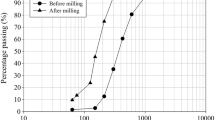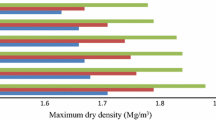Abstract
A reddish brown lateritic soil treated with up to 15% blast furnace slag was compacted with three compactive efforts, (standard Proctor, West African Standard and modified Proctor) with moulding water contents ranging between 10 and 20% of weight of dry mixture. Compacted samples were extruded and allowed to dry in the laboratory for 30 days with measurements taken every 5 days to monitor volumetric changes due to drying. Four specimens compacted on the wet side of optimum using standard proctor effort; at the various slag treatments after 10 days of drying were subjected to four cycles of drying and three cycles of wetting. The results obtained showed that the changes in mass and volumetric shrinkage were rapid within the first 5 days of drying. These changes were proportional to the moulding water contents and were unaffected by the compactive effort. The volumetric shrinkage strain increased with increasing moulding water content and compactive efforts. As the water content relative to the optimum increased towards the wet side, the volumetric shrinkage strain increased and it decreased towards the dry side. For all compaction energies, the initial degree of saturation increased and regardless of the slag content, the volumetric shrinkage strain increased. As the slag content increased, the initial degree of saturation at which the permissible 4% volumetric shrinkage occurred increased. Slag content had marginal effects on the volumetric shrinkage strain as no clear trend was established. For each slag treatment the volumetric shrinkage strain did not vary significantly with increasing number of drying cycles.


















Similar content being viewed by others
References
Afolayan JO, Nwaiwu CMO, Osinubi KJ (2005). Comparative reliability evaluation of lateritic soils as hydraulic barriers. Geotechnical and Geological Engineering, Kluver Academic Publishers, Netherlands (PDF output on internet as at June 2004)
Albrecht BA, Benson CH (2001) Effect of desiccation on compacted natural clay. J Geotech Geoenvir Eng, ASCE 127(1):67–75
Bae S, Inyang HI (2006) Confirmation of aqueous polymer sorption on contaminant barrier clay using TGA. J Mater Civil Eng, ASCE 18(2):307–309
Bendz TE, Bengtsson L (1996) Evaporation from an active, uncovered landfill. J Hydrol 182(1–4):143–155
Benson CH, Khire M (1997) Earthen materials in surface barriers. Barrier technologies for environmental management. National Academy Press, National Research Council, D79–D89
Benson CH, Zhai H, Wang X (1994) Estimating hydraulic conductivity of compacted clay liners. J Geotech Eng, ASCE 120(2):366–387
British Standards Institute (1990) Methods of test for soils for civil engineering purposes, BS 1377, London, United Kingdom
Croney D, Coleman J (1954) Soil structure in relation to soil suction. J Soil Sci 5(1):75–84
Daniel DE (1987) Earthen liners for land disposal facilities. Geotechnical practice for waste disposal’87. In: RD Woods (ed) ASCE geotechnical special publication no. 13, New York, pp 21–39
Daniel DE, Wu YK (1993) Compacted clay liners and covers for arid site. J Geotech Eng, ASCE 119(2):223–237
Dejong E, Warkentin BP (1965) Shrinkage of soil samples with varying clay content. Canadian Geotech J 2(1):16–22
Earth Manual (1974) US Goverment printing office Washington, DC, 2nd ed, vol 60, pp 20–21
Ghezzehei TA, Or D (2001) Rheological properties of wet soils and clay under steady and oscillatory stresses. Soil Sci Soc Am J 65(3):624–637
Haienes W (1923) The volume changes associated with variations of water content in soils. J Agric Sci 13:296–310
Holtz WG (1985) Discussion of predicting the hydraulic conductivity of clay liners. By Daniel DE, Journal of Geotechnology Engineering, A.S.C.E. 111. 12:1457–1459
Khire MV, Benson CG, Bosscher PJ (1997) Water balance modeling of earthen landfill covers. J Geotech Geoenvir Eng, A.S.C.E., 123(8):744–754
Kleppe JH, Olson RE (1985) Desiccation cracking of soil barriers. In: Johnson AJ, Frobel RK, Cavallis NJ, Patterson CB (eds) Hydraulic barrier in soil and rock. ASTM S.T.P. 874, ASTM, Philadelphia, PA, pp 263–275
Kraus JF, Benson CH, Maltby VC, Wang X (1997) Laboratory and field hydraulic conductivity of three compacted paper mill sludges. J Geotech Geoenvir Eng, ASCE 123(7):654–662
Mitchell JK (1976) Fundamental of soil behaviour. Wiley, London, p 422
Mitchell JK, Hoper DR, Campanella RG (1965) Permeability of compacted clay. J Soil Mech Found Division ASCE 91(4):41–65
Nigerian General Specification (1997) Roads and bridges. Federal Ministry of Works and Housing, Abuja, Nigeria
Nwaiwu CMO, Afolayan JO, Osinubi KJ (2005a) Predicting hydraulic conductivity of compacted lateritic soils A reliability approach. Electronic Journal of Geotechnical Engineering, vol. 10, Bundle D, pp 1–17
Nwaiw CMO, Osinubi KJ, Afolayan JO (2005) Statistical evaluation of hydraulic conductivity of compacted lateritic soils. Geotech Test J 28(6):1–10
Osinubi KJ (1998a) Influence of compactive efforts and compaction delays on lime-treated soil. J Transp Eng, ASCE 124(2):149–155
Osinubi KJ (1998b) Permeability of lime-treated lateritic soil. J Transp Eng, ASCE 124(5):465-469
Osinubi KJ, Eberemu AO (2005) The use of ground blast furnace slag and laterite in the attenuation of groundwater contaminants. Proceeding 4th nigerian material congress (NIMACON 2005) Nov 17–19th, Zaria, Nigeria, pp 28–35
Osinubi KJ, Nwaiwu CMO (2002) Compacted lateritic soils as hydraulic barrier in waste containment systems. Proceeding 4th interational congress on environmental geotechnics (ICEG), Rio De Janeiro, Brazil, 11–15th August, pp 225–230
Osinubi KJ, Nwaiwu CMO (2005) Hydraulic conductivity of compacted lateritic soil. J Geotech Geoenviron Eng, ASCE 131(8):1034–1041
Osinubi KJ, Nwaiwu CMO (2006) Design of compacted lateritic soil liners and covers. J Geotech Geoenviron Eng, ASCE 132(2):203–213
Ritchie JT, Adams JE (1974) Field measurement of evaporation from soil shrinkage cracks. Soil Sci Soc Am Proc 38(1):131–134
Shelley LT, Daniel ED (1993) Effect of gravel on hydraulic conductivity of compacted soil liners. J Geotech Eng, ASCE 119(1):54–67
Author information
Authors and Affiliations
Corresponding author
Rights and permissions
About this article
Cite this article
Osinubi, K.J., Eberemu, A.O. Desiccation Induced Shrinkage of Compacted Lateritic Soil Treated with Blast Furnace Slag. Geotech Geol Eng 28, 537–547 (2010). https://doi.org/10.1007/s10706-010-9308-6
Received:
Accepted:
Published:
Issue Date:
DOI: https://doi.org/10.1007/s10706-010-9308-6




